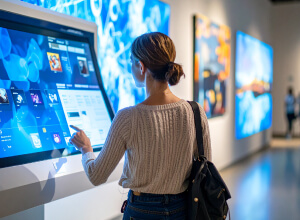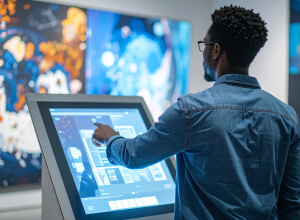Digital Menu Board Trends That Drive More Sales

Explore the latest digital menu board trends driving sales in various industries. Learn how dynamic pricing, real-time updates, personalized recommendations, and AI integration can transform customer experiences and boost revenue. Stay ahead with insights into innovative uses of digital signage.
Digital menu boards are continually evolving, leveraging advanced tools and the creativity of designers and developers. These boards are more than just a high-tech replacement for static menus; they are strategic assets that can significantly enhance customer engagement and drive sales. In an increasingly competitive market, businesses are looking for innovative ways to boost revenue. Here are some of the latest digital menu board trends designed to increase sales.
Dynamic Pricing
Dynamic pricing allows businesses to adjust their prices in response to market demand, much like how ride-sharing services adjust fares based on peak times. This flexibility is particularly advantageous in the food service industry, where demand fluctuates throughout the day. For instance, during off-peak hours, a restaurant might lower prices to attract more customers, while prices might increase during busy times to maximize profit. Dynamic pricing helps manage supply and demand more effectively, ensuring that menu items are priced optimally at all times. This approach not only maximizes revenue but also enhances customer satisfaction by offering value-based pricing. Digital menu boards make it easy to update prices instantly, providing the agility needed to implement dynamic pricing strategies efficiently.
Real-Time Updates
Another key advantage of digital menu boards is the ability to make real-time updates. Gone are the days of static menus requiring costly reprints every time you make a change. With digital boards, you can update your products and prices at scale, instantly.
Real-time updates are not just efficient; they can also help drive sales by ensuring your menu always showcases the most profitable items. If a product is out of stock, you can remove it from the menu immediately, preventing customer disappointment and potential lost sales.
This capability also enables you to test new products or promotions easily. You can introduce a new item and track its performance in real-time. If it’s a hit, you can keep it on the menu. If not, you can swap it out for something else without any hassle.
Personalized Recommendations
Personalization is a powerful tool in today’s marketing landscape, and digital menu boards are no exception. By integrating customer data, such as past purchases or preferences, table-side digital menus can offer personalized recommendations. For instance, customers who frequently order vegetarian dishes might see a highlighted section of vegetarian specials. This level of customization not only makes the dining experience more enjoyable but also encourages repeat business. Personalized recommendations can increase the average transaction value by suggesting complementary items the customer will likely enjoy. This strategy leverages data-driven insights to create a tailored experience that meets individual customer needs and boosts sales.

Upselling and Cross-Selling
Upselling and cross-selling are classic sales techniques that remain highly effective. Digital menu boards provide an excellent platform to implement these strategies. By using data and interactive features, you can suggest complementary items or upgrades to enhance the customer’s purchase.
For example, if a customer selects a burger, your menu board can suggest adding fries and a drink for a discounted price. Or, if they choose a regular coffee, you can offer an upgrade to a larger size or a premium blend. These subtle prompts can lead to higher average order values and increased revenue.
The key to successful upselling and cross-selling is to make the suggestions relevant and appealing. Digital menu boards can analyze customer behavior and preferences to offer personalized recommendations that feel natural and helpful rather than pushy.
Integration with AI and Machine Learning
Artificial intelligence (AI) and machine learning (ML) are revolutionizing many aspects of business, and digital menu boards are no exception. By leveraging AI and ML, you can gain deeper insights into customer behavior and preferences, allowing for more effective sales strategies.
AI can analyze vast amounts of data to identify patterns and trends that might not be immediately apparent. For example, it can determine which items are most popular at different times of the day or week, and adjust the menu accordingly. This can help optimize inventory management and reduce waste.
Machine learning algorithms can also be used to make real-time adjustments to the menu based on current conditions. For example, if a certain item is selling particularly well, the menu board can automatically highlight it to encourage more sales. Conversely, if an item is underperforming, it can be replaced with a more popular option.
Conclusion
In conclusion, digital menu boards offer a wealth of opportunities to increase sales and improve the customer experience. By staying up-to-date with the latest trends and technologies, you can ensure that your business remains competitive and continues to grow. Implementing dynamic pricing, real-time updates, personalized recommendations, upselling and cross-selling techniques, and AI/ML can help you achieve your sales goals and create a memorable dining experience for your customers.




